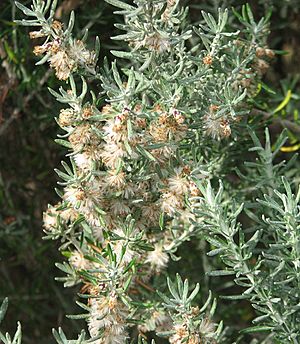Coastal daisy-bush facts for kids
Quick facts for kids Olearia axillaris |
|
|---|---|
 |
|
| Scientific classification | |
| Genus: |
Olearia
|
| Species: |
axillaris
|
Olearia axillaris is a cool shrub that grows along the coast of Australia. It's part of the Asteraceae family, which includes daisies! People often call it the coastal daisybush or wild rosemary. It was one of the first Australian plants that Europeans learned they could eat.
Contents
What Does it Look Like?
This plant is a tall, bushy shrub that can grow up to 2 metres high. It has many branches and is covered in tiny leaves, giving it a shiny, silver-green look. You can easily spot it in sand dunes because of its height. This plant is a pioneer, meaning it's one of the first to grow in new areas like dunes. It can handle strong winds, salty air, and poor soil.
Leaves and Flowers
The leaves are small and grow in circles around the stem. They are covered in fine white hairs, which make the shrub look silvery. Each leaf is about 12 mm long and 1 to 3 mm wide. They are long and thin, with edges that roll inwards. If you crush them, they smell nice! Older leaves might lose their fuzzy coating and become smooth and green.
The flowers have yellow centres and are surrounded by white leaf-like parts called bracts. After the flowers, the plant makes small fruits called achenes. These are about 1.5 to 2 mm long. They have feathery bristles, called a pappus, that are twice as long as the fruit. These bristles help the seeds fly away in the wind.
Where Does it Grow?
You can find Olearia axillaris along the southern coasts of Western Australia, South Australia, Victoria, New South Wales, and Tasmania. It often grows in sand dunes. You might also see it on limestone or rocky slopes near the ocean. While it usually sticks to the coast in most states, some plants in Western Australia have been found growing inland in similar sandy areas.
A Taste of History
Long ago, two early explorers visited the coast of Western Australia. They were Willem de Vlamingh and William Dampier. They both tried eating this plant! Its nice smell made them think it could be used as a herb. Vlamingh's crew even used the leaves they collected from Rottnest Island. They added them to their simple meals on the ship.
Images for kids


